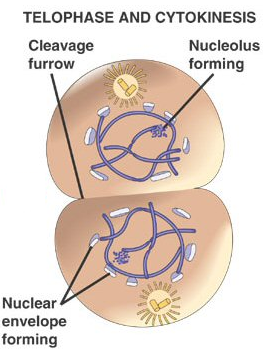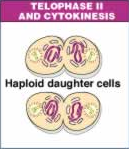Telophase: Difference between revisions
No edit summary |
No edit summary |
||
| Line 3: | Line 3: | ||
<br> | <br> | ||
'''Telophase in mitosis<br>'''During this phase, the cell splits (also known as [[Cytokinesis|cytokinesis]]) into two identical cells due to the formation of a [[Nuclear envelope|nuclear envelope which]] gathers around each group of compacted [[Chromosome|chromosomes]]. These chromosomes decondense so that they eventually become no longer visible. The spindle formed during metaphase disappears making the two newly formed identical cells look like they are in the early stages of [[Interphase|interphase]]. <ref name="null">Hartl and Ruvolo,Genetics: Analysis of genes and genomes,8th edition(2012 | '''Telophase in mitosis<br>'''During this phase, the cell splits (also known as [[Cytokinesis|cytokinesis]]) into two identical cells due to the formation of a [[Nuclear envelope|nuclear envelope which]] gathers around each group of compacted [[Chromosome|chromosomes]]. These chromosomes decondense so that they eventually become no longer visible. The spindle formed during metaphase disappears making the two newly formed identical cells look like they are in the early stages of [[Interphase|interphase]]. <ref name="null">Hartl and Ruvolo,Genetics: Analysis of genes and genomes,8th edition(2012, Jones and Bartlett Learning, page 122</ref> | ||
[[Image:Telophase mitosis.png|A representation of the cell division stage telophase during mitosis.]] | [[Image:Telophase mitosis.png|A representation of the cell division stage telophase during mitosis.]] | ||
<br>'''Telophase in meiosis<br>'''Meiosis contains two cell divisions. The difference between telophase I in meiosis and telophase during mitosis is the fact that located close to each pole of the spindle is a [[Haploid|haploid]] set of chromosomes. These are made up of one homolog from each of the [[Homologues|homologous]] chromosomes. The nuclear envelope still forms and the spindle still disappears due to it being broken down. Limited uncoiling occurs before the chromosomes move onto the second [[Cell division|cell division stage]] in meiosis (telophase II). <ref name="null">Hartl and Ruvolo,Genetics: Analysis of genes and genomes,8th edition(2012),Jones and Bartlett Learning, page 130</ref> | <br>'''Telophase in meiosis<br>'''Meiosis contains two cell divisions. The difference between telophase I in meiosis and telophase during mitosis is the fact that located close to each pole of the spindle is a [[Haploid|haploid]] set of chromosomes. These are made up of one homolog from each of the [[Homologues|homologous]] chromosomes. The nuclear envelope still forms and the spindle still disappears due to it being broken down. Limited uncoiling occurs before the chromosomes move onto the second [[Cell division|cell division stage]] in meiosis (telophase II). <ref name="null">Hartl and Ruvolo,Genetics: Analysis of genes and genomes,8th edition(2012),Jones and Bartlett Learning, page 130</ref> | ||
[[Image:Telophase I meiosis.png|A representation of telophase during the first cell division of meiosis (meiosis I).]] | [[Image:Telophase I meiosis.png|A representation of telophase during the first cell division of meiosis (meiosis I).]] | ||
Revision as of 21:42, 14 November 2011
Telophase is an important cycle in cell division and occurs at the end of the cycle. It is present in mitosis but also in the two division stages of meiosis (telophase I and telophase II).
Telophase in mitosis
During this phase, the cell splits (also known as cytokinesis) into two identical cells due to the formation of a nuclear envelope which gathers around each group of compacted chromosomes. These chromosomes decondense so that they eventually become no longer visible. The spindle formed during metaphase disappears making the two newly formed identical cells look like they are in the early stages of interphase. [1]
Telophase in meiosis
Meiosis contains two cell divisions. The difference between telophase I in meiosis and telophase during mitosis is the fact that located close to each pole of the spindle is a haploid set of chromosomes. These are made up of one homolog from each of the homologous chromosomes. The nuclear envelope still forms and the spindle still disappears due to it being broken down. Limited uncoiling occurs before the chromosomes move onto the second cell division stage in meiosis (telophase II). [1]
Telophase II also shows a likeness to that of telophase in mitosis. The movement of the four genetically unidentical cells (with haploid nuclei) into interphase is complemented by cytoplasm division. During prophase, the formation of the chaismata leads to crossing over; hence why the four cells are not identical as seen in mitosis.[1]
References


